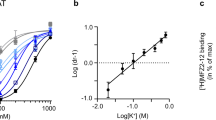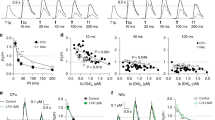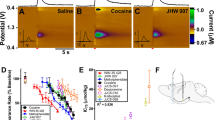Abstract
THE (Na+ + K+)ATPase, an integral membrane protein located in virtually all animal cells, couples the hydrolysis of ATP to the countertransport of Na+ and K+ ions across the plasma membrane1,2. In neurons, a large portion of cellular energy is expended by this enzyme to maintain the ionic gradients that underlie resting and action potentials. Although neurotransmitter regulation of the enzyme in brain has been reported3,4, such regulation has been characterized either as a nonspecific phenomenon5,6 or as an indirect effect of neurotransmitter-induced changes in ionic gradients7. We report here that the neurotransmitter dopamine, through a synergistic effect on D1 and D2 receptors, inhibits the (Na+ + K+)ATPase activity of isolated striatal neurons. Our data provide unequivocal evidence for regulation by a neurotransmitter of a neuronal ion pump. They also demonstrate that synergism between D1 and D2 receptors, which underlies many of the electrophysical and behavioural effects of dopamine in the mammalian brain8, can occur on the same neuron. In addition, the results support the possibility that dopamine and other neurotransmitters can regulate neuronal excitability through the novel mechanism of pump inhibition.
This is a preview of subscription content, access via your institution
Access options
Subscribe to this journal
Receive 51 print issues and online access
$199.00 per year
only $3.90 per issue
Buy this article
- Purchase on Springer Link
- Instant access to full article PDF
Prices may be subject to local taxes which are calculated during checkout
Similar content being viewed by others
References
Skou, J. C. Physiol. Rev. 45, 596–617 (1965).
Glynn, I. M. in The Enzymes of Biological Membranes (ed. Martonosi, A. N.) 35–114 (Plenum, New York, 1985).
Phillis, J. W. & Wu, P. H. Prog. Neurobiol. 17, 141–184 (1981).
Smith, P. A. Trends pharmac. Sci. 422–425 (1984).
Van der Krogt, J. & Belfriod, R. D. M. Biochem. Pharmac. 29, 857–868 (1980).
Lafferty, P., Jackson, D. M. & Malor, R. Biochem. Pharmac. 34, 3591–3596 (1985).
Smith, P. A., Thompson, E. L. & Zidichouski, J. A. Neurosci. Lett. 71, 72–76 (1986).
Clark, D. & White, F. J. Synapse 1, 347–388 (1987).
Gerfen, C. J. Electron Microsc. Tech. 10, 265–281 (1988).
Da Prada, M., Keller, H. H., Pieri, L., Kettler, R. & Haefely, W. E. Experimentia 40, 1165–1171 (1984).
Aperia, A., Bertorello, A. & Seri, I. Am. J. Physiol. 252, F39–F45 (1987).
Bertorello, A. & Aperia, A. Acta physiol. scand. 132, 441–443 (1988).
Bertorello, A. & Aperia, A. Am. J. Physiol. 256, F57–F69 (1989).
Bertorello, A. & Aperia, A. Am. J. Physiol. 256, F370–F373 (1989).
Bertorello, A. & Aperia, A. Acta physiol. scand. 130, 571–574 (1987).
Gadsby, D. C. Nature 306, 691–693 (1983).
Carlsson, A. Neuropsychopharmacology 1, 179–186 (1988).
Freedman, J. E. & Weight, F. F. Proc. natn. Acad. Sci. U.S.A. 85, 3618–3622 (1988).
Mercuri, N. et al. Brain Res. 385, 110–121 (1985).
Richfield, E. K., Penny, J. B. & Young, A. B. Neuroscience 30, 767–777 (1989).
Stoof, J. C. & Kebabian J. W. Life Sci. 35, 2281–2296 (1984).
Wang, R. Y., White, F. J., Mereu, G. & Hu, X. T. in Dopamine Receptors (ed. Creese, I.) 153–173 (Alan Liss, New York, 1987).
Kebabian, J. W., Petzold, G. L. & Greengard, P. Proc. natn. Acad. Sci. U.S.A. 69, 2145–2149 (1972).
Hemmings, H. C., Walaas, I. S., Ouimet, C. C. & Greengard, P. in Receptor Biochemistry and Methodology, Vol. 9: Structure and Function of Dopamine Receptors (eds Creese, I. & Fraser, C. M.) 115–151 (Liss, New York, 1987).
Kay, A. R. & Wong, R. K. S. J. Neurosci. Meth. 16, 227–238 (1986).
Bradford, M. M. Analyt. Biochem. 72, 248–254 (1976).
Sharp, T., Zetterstrom, T. & Ungerstedt, U. J. Neurochem 47, 113–122 (1986).
Lowry, O. K., Rosebrough, N. J., Farr, A. L. & Randall, R. J. J. biol. Chem. 193, 265–275 (1951).
Author information
Authors and Affiliations
Rights and permissions
About this article
Cite this article
Bertorello, A., Hopfield, J., Aperia, A. et al. Inhibition by dopamine of (Na+ + K+)ATPase activity in neostriatal neurons through D1 and D2 dopamine receptor synergism. Nature 347, 386–388 (1990). https://doi.org/10.1038/347386a0
Received:
Published:
Issue Date:
DOI: https://doi.org/10.1038/347386a0
This article is cited by
-
Dopamine: Functions, Signaling, and Association with Neurological Diseases
Cellular and Molecular Neurobiology (2019)
-
Na+/K+-pump and neurotransmitter membrane receptors
Invertebrate Neuroscience (2019)
-
The characterization of neuroenergetic effects of chronic L-tyrosine administration in young rats: evidence for striatal susceptibility
Metabolic Brain Disease (2015)
-
Genome-Wide Analyses of Working-Memory Ability: A Review
Current Behavioral Neuroscience Reports (2014)
-
Na+,K+-ATPase as a docking station: protein–protein complexes of the Na+,K+-ATPase
Cellular and Molecular Life Sciences (2013)
Comments
By submitting a comment you agree to abide by our Terms and Community Guidelines. If you find something abusive or that does not comply with our terms or guidelines please flag it as inappropriate.



